Do you have a question about the Boss Dr. Rhythm DR-670 and is the answer not in the manual?
Indicates how buttons, numerals, and references are displayed.
Covers general warnings, cautions, placement, and protection guidelines.
Overview of core functionalities like bass parts, sound quality, display, and operation.
Guidelines for power supply, unit placement, maintenance, data backup, and repairs.
Detailed explanation of the controls and connectors on the front and rear panels.
Guide to installing batteries, making connections, powering on, and basic functions.
Covers pattern selection, DPP, tempo, fills, and drum kit switching.
Using foot switches, creating songs, and combining functions.
Outlines song/pattern creation, operational modes, and drum kit basics.
How to interpret displays and use the SHIFT button for functions.
Triggering sounds with key pads, playing patterns, and using DPP.
Using Rolls, Flams, Fret Shift, tempo adjustments, and fill-ins.
Controlling performances and fills with external foot switches.
Steps for selecting, quantizing, and recording basic and fill patterns.
Erasing, copying patterns, and modifying drum kits and bass parts.
Realtime and step recording for creating songs.
Inserting, deleting, clearing, copying, and chaining songs.
Selecting and playing songs, controlling playback, and using song repeat.
Starting songs from specific points and linking songs via song chain.
Linking patterns to key pads for instant trigger via DPP.
Adjusting output parts, foot switches, metronome, and sound parameters.
Selecting, editing drum/bass parts, and adjusting parameters.
Duplicating existing drum kits to User slots.
Understanding MIDI, connectors, modes, and device synchronization.
Bulk Dump/Load, MIDI channels, and using the DR-670 with the BR-8.
Explains common error messages and provides troubleshooting steps.
Solutions for common operational problems like no sound or recording issues.
A comprehensive list of operations and their purposes across different modes.
Details of adjustable system, song, pattern, kit, and MIDI parameters.
A catalog of all available internal drum and bass sounds.
A list of all factory preset drum kits and their pad assignments.
A catalog of all built-in rhythm patterns with recommended tempos.
Technical chart detailing MIDI message compatibility.
Technical details including polyphony, dimensions, power, and connectors.
Alphabetical listing of topics and their page numbers.
Indicates how buttons, numerals, and references are displayed.
Covers general warnings, cautions, placement, and protection guidelines.
Overview of core functionalities like bass parts, sound quality, display, and operation.
Guidelines for power supply, unit placement, maintenance, data backup, and repairs.
Detailed explanation of the controls and connectors on the front and rear panels.
Guide to installing batteries, making connections, powering on, and basic functions.
Covers pattern selection, DPP, tempo, fills, and drum kit switching.
Using foot switches, creating songs, and combining functions.
Outlines song/pattern creation, operational modes, and drum kit basics.
How to interpret displays and use the SHIFT button for functions.
Triggering sounds with key pads, playing patterns, and using DPP.
Using Rolls, Flams, Fret Shift, tempo adjustments, and fill-ins.
Controlling performances and fills with external foot switches.
Steps for selecting, quantizing, and recording basic and fill patterns.
Erasing, copying patterns, and modifying drum kits and bass parts.
Realtime and step recording for creating songs.
Inserting, deleting, clearing, copying, and chaining songs.
Selecting and playing songs, controlling playback, and using song repeat.
Starting songs from specific points and linking songs via song chain.
Linking patterns to key pads for instant trigger via DPP.
Adjusting output parts, foot switches, metronome, and sound parameters.
Selecting, editing drum/bass parts, and adjusting parameters.
Duplicating existing drum kits to User slots.
Understanding MIDI, connectors, modes, and device synchronization.
Bulk Dump/Load, MIDI channels, and using the DR-670 with the BR-8.
Explains common error messages and provides troubleshooting steps.
Solutions for common operational problems like no sound or recording issues.
A comprehensive list of operations and their purposes across different modes.
Details of adjustable system, song, pattern, kit, and MIDI parameters.
A catalog of all available internal drum and bass sounds.
A list of all factory preset drum kits and their pad assignments.
A catalog of all built-in rhythm patterns with recommended tempos.
Technical chart detailing MIDI message compatibility.
Technical details including polyphony, dimensions, power, and connectors.
Alphabetical listing of topics and their page numbers.
| Type | Drum Machine |
|---|---|
| Pads | 8 velocity-sensitive pads |
| Display | LCD |
| MIDI | In/Out |
| Sequencer | Yes |
| Power Supply | AC adapter or 6 AA batteries |
| Effects | Reverb |
| Outputs | Stereo Out, Headphone Out |
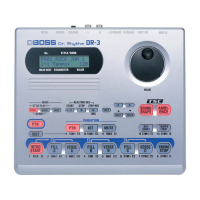
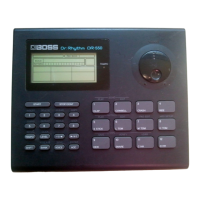
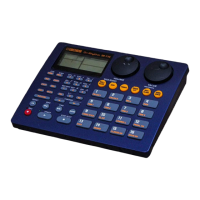
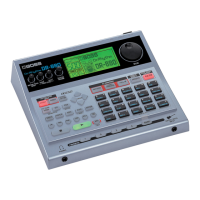
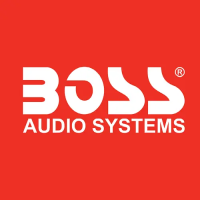
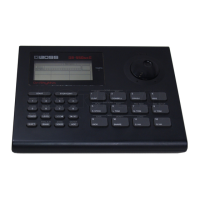
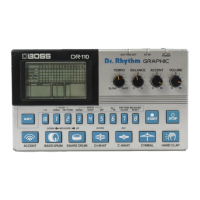
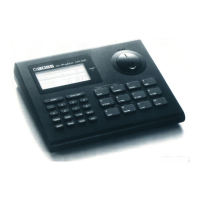
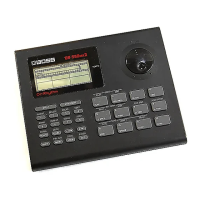
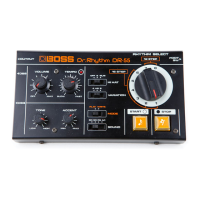
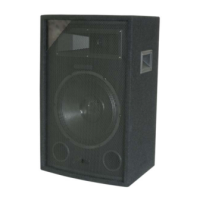
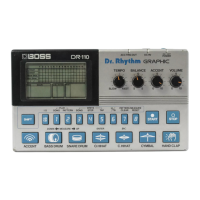
